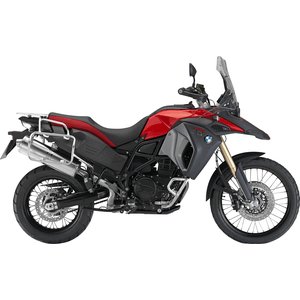BMW F 800 GS Adventure [2013-2016]: The Globetrotter’s Swiss Army Knife

Introduction
The BMW F 800 GS Adventure isn’t just a motorcycle—it’s a declaration of intent. Built for riders who view highways as mere suggestions and dirt trails as invitations, this mid-size adventure bike carved its niche between 2013 and 2016 as a machine equally at home crossing continents as it is conquering rocky riverbeds. With its reinforced chassis, marathon fuel range, and tech-forward features, the F 800 GS Adventure remains a benchmark for riders who refuse to choose between exploration and practicality. Having spent time in the saddle, I can confirm: this bike doesn’t just handle adventure—it demands it.
Engine and Performance: Torque Meets Tenacity
At the heart of the F 800 GS Adventure lies BMW’s 798cc liquid-cooled parallel-twin engine, a workhorse that delivers 85 hp (63 kW) at 7,500 rpm and 83 Nm (61 lb-ft) of torque at 5,750 rpm. The engine’s forward-leaning design isn’t just for show—it centralizes mass, giving the bike a surprisingly nimble feel despite its 229 kg (505 lbs) wet weight.
On the road, the powerband is butter-smooth from 3,000 rpm onward, with a linear surge that makes overtaking effortless. The throttle response is crisp, thanks to the 45mm electronic fuel injection, and the six-speed transmission slots gears with a satisfying mechanical click. While the engine isn’t vibration-free—expect a mild buzz in the handlebars at highway speeds—it’s far from intrusive, even during eight-hour days in the saddle.
Off-road, the parallel-twin shines. Unlike high-revving triples or twins, this engine prioritizes low-end grunt. Second gear becomes your best friend on technical trails, tractoring up inclines without fuss. The optional Enduro mode (paired with ASC) raises the ABS and traction control slip thresholds, allowing controlled slides on loose gravel—a feature that feels like cheating in the best possible way.
Fuel efficiency is a standout: BMW claims 4.3 L/100 km (55 mpg), and real-world riding often matches this. With its 24L (6.3-gallon) tank, range stretches to 550 km (340 miles), making it a Sahara-ready companion.
On-Road Manners: Touring Without Compromise
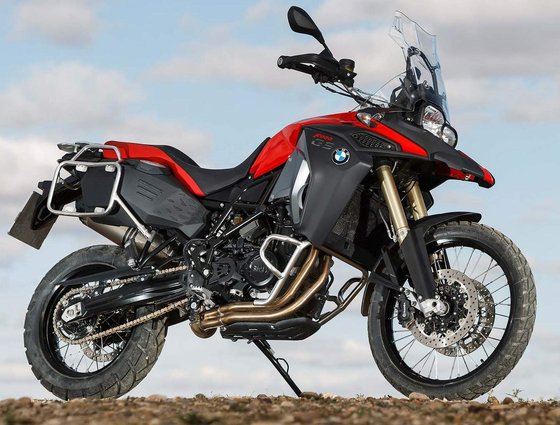
The F 800 GS Adventure’s touring credentials are undeniable. The adjustable windscreen deflects air cleanly over a rider’s helmet, and the bench seat—firm at first sit—proves its worth after hour three. The upright riding position is ergonomic heaven, with wide handlebars offering leverage for quick directional changes.
Where this bike surprises is its pavement agility. The 21-inch front wheel and 230mm suspension travel (front) absorb potholes like a luxury sedan, while the steel tubular frame remains composed during spirited cornering. The ABS-equipped dual 300mm front discs provide confident stops, though the initial bite is softer than sport bikes—a deliberate choice for dirt-to-tarmac transitions.
Off-Road Prowess: Born to Roam
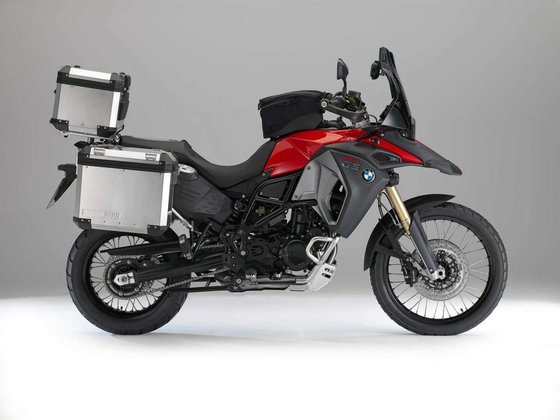
Switch to a gravel road, and the F 800 GS Adventure transforms. The 890mm (35-inch) seat height intimidates shorter riders, but the narrow chassis and low center of gravity (thanks to the under-seat fuel tank) inspire confidence once moving. The spoked wheels shod with knobby tires (Continental TKC80s were a popular factory option) grip like claws in mud, while the long-travel suspension soaks up whoops and ruts without bottoming out.
The reinforced steel subframe and engine guard are more than cosmetic—they’re crash-tested armor for inevitable tip-overs. During a steep descent in rocky terrain, the bike’s 505 lbs (229 kg) heft becomes apparent, but the torquey engine and precise clutch modulation make slow-speed maneuvers manageable.
Ergonomics and Comfort: Designed for the Long Haul
BMW’s focus on endurance riding shines here. The handguards and adjustable levers accommodate gloved hands, while the wide enduro footpegs (with removable rubber dampers) offer multiple standing positions. The optional heated grips (part of the Comfort Package) are a revelation in alpine conditions.
Two criticisms: The stock seat’s foam densifies over time, and the analog speedometer’s small font strains readability. Thankfully, BMW’s accessory catalog addresses both—MOTOPARTS.store offers gel seat upgrades and GPS mounts to supplement the dash.
Technology: Ahead of Its Time
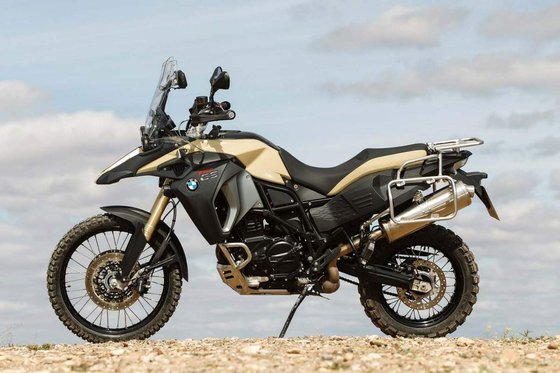
For a mid-2010s bike, the F 800 GS Adventure’s tech suite remains impressive:
- ABS Pro (standard): Disengageable for off-road use.
- Automatic Stability Control (ASC): Prevents rear-wheel spin on slick surfaces.
- Electronic Suspension Adjustment (ESA): Adjusts rear damping on the fly (optional).
- Enduro Mode: Tailors ABS/ASC for dirt (requires ASC option).
The menu system, controlled via left-hand switches, is intuitive—no submenu diving required mid-ride.
Competition: How Does It Stack Up?
The F 800 GS Adventure’s closest rival was (and remains) the Triumph Tiger 800XC. Let’s break it down:
| Feature | BMW F 800 GS Adventure | Triumph Tiger 800XC |
|------------------------|-------------------------------|-------------------------------|
| Engine | 85 hp parallel-twin | 95 hp inline-triple |
| Fuel Capacity | 24L (6.3 gal) | 19L (5.0 gal) |
| Seat Height | 890mm (35") | 840mm (33") |
| Weight | 229 kg (505 lbs) | 215 kg (474 lbs) |
| Tech | ASC, ESA, Enduro Mode | No traction control (2013-16) |
Verdict: The Tiger’s triple is smoother and more powerful on pavement, but the BMW’s fuel range, off-road chops, and tech edge make it the better all-rounder. The KTM 790 Adventure (released later) surpasses both in agility but lacks the BMW’s tank durability.
Maintenance: Keeping the Adventure Alive

The F 800 GS Adventure is built to endure, but smart maintenance is key:
1. Oil Changes: Use SAE 15W-50 (2.9L with filter). MOTOPARTS.store stocks OEM-spec filters.
2. Chain Care: The O-ring chain needs regular cleaning and lubrication—especially after off-road use. Consider upgrading to a DID Heavy Duty chain.
3. Valve Checks: Every 20,000 km (12,400 miles). Shim-under-bucket design requires patience but no special tools.
4. Coolant: Replace every 4 years with BMW’s “Wasser+” formula (anti-corrosion additives).
5. Brakes: DOT 4 fluid changes every 2 years. Swap pads for sintered ones if riding loaded.
Pro Tip: The dry sump design reduces oil starvation risks during steep inclines—but always check levels pre-ride.
Conclusion: The Legacy of a Modern Classic
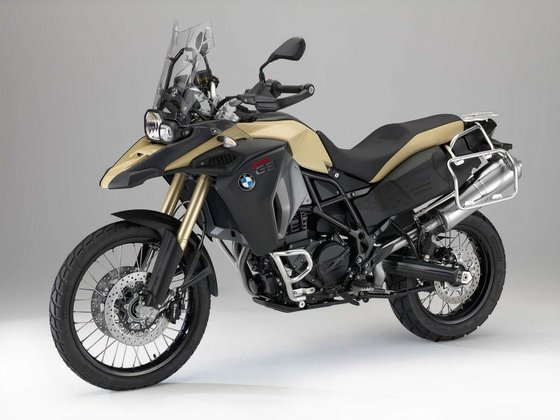
The BMW F 800 GS Adventure isn’t perfect—its weight and vibrations remind you it’s no featherweight—but its flaws fade against its versatility. This is a bike that’ll carve Alpine passes at dawn, ford Mongolian streams by noon, and still coddle you through a 500-mile highway slog. For riders seeking a single machine to handle 90% of Earth’s terrain (and 100% of their wanderlust), the F 800 GS Adventure remains a compelling choice.
At MOTOPARTS.store, we’re committed to keeping your GS Adventure ready for the next horizon. From upgraded suspension kits to crash-resistant panniers, our catalog ensures your BMW ages like a fine whiskey—bold, complex, and infinitely rewarding.
Ride far. Ride often. Let the journey define you.









Specifications sheet
| Engine | |
|---|---|
| Stroke: | Four-stroke |
| Cooling: | Liquid cooled |
| Max power: | 63 kW | 84.0 hp |
| Max torque: | 83 Nm |
| Fuel system: | Electronic fuel injection, 45mm throttle bodies |
| Lubrication: | Dry sump |
| Max power @: | 7500 rpm |
| Displacement: | 798 ccm |
| Max torque @: | 5750 rpm |
| Configuration: | Inline |
| Compression ratio: | 12.0:1 |
| Number of cylinders: | 2 |
| Dimensions | |
|---|---|
| Wheelbase: | 1577 mm (62.1 in) |
| Dry weight: | 214 |
| Wet weight: | 229 |
| Seat height: | 890 mm (35.0 in) / 860 mm (33.9 in) |
| Overall width: | 925 mm (36.4 in) |
| Overall height: | 1450 mm (57.1 in) |
| Overall length: | 2304 mm (90.7 in) |
| Ground clearance: | 165 mm (6.5 in) |
| Fuel tank capacity: | 24 L (6.3 US gal) |
| Drivetrain | |
|---|---|
| Final drive: | chain |
| Gear ratios: | ['1st 2.46', '2nd 1.75', '3rd 1.38', '4th 1.17', '5th 1.04', '6th 0.96'] |
| Transmission: | 6-speed |
| Final drive ratio: | 1:2.6 |
| Maintenance | |
|---|---|
| Rear tire: | 150/70-17 |
| Engine oil: | 15W50 |
| Front tire: | 90/90-21 |
| Break fluid: | DOT 4 |
| Spark plugs: | NGK DCPR8E or NGK DCPR8EIX |
| Spark plug gap: | 0.8–0.9 mm |
| Engine oil capacity: | 2.9 |
| Valve clearance (intake, cold): | 0.10–0.20 mm |
| Valve clearance (exhaust, cold): | 0.20–0.30 mm |
| Additional Features | |
|---|---|
| ABS: | Standard with switchable off-road mode |
| Fuel gauge: | Standard with reserve indicator |
| Traction control: | Optional ASC (Automatic Stability Control) |
| Standard accessories: | Engine protection bar, pannier racks, hand guards |
| Suspension adjustment: | Optional ESA (Electronic Suspension Adjustment) |
| Chassis and Suspension | |
|---|---|
| Frame: | Tubular steel space frame |
| Rear brakes: | Single 265 mm disc, 2-piston caliper (ABS standard) |
| Front brakes: | Dual 300 mm discs, 4-piston calipers (ABS standard) |
| Rear suspension: | Aluminum swingarm with monoshock, 215 mm travel |
| Front suspension: | 43mm Marzocchi USD forks, 230 mm travel |
| Rear wheel travel: | 215 mm (8.5 in) |
| Front wheel travel: | 230 mm (9.1 in) |



